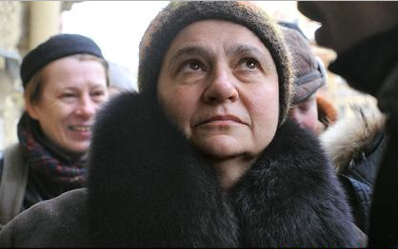Yelena Basner’s house arrest is extended
Sep 20th, 2014 | By Ivan Lindsay | Category: Journal
Art Historian Yelena Basner remains under house arrest over her role in the sale of the disputed Grigoriev painting, ‘The Paris Cafe.’
RAPSI, The Russian Legal Information Agency reported on the 16th September that The Oktyabrsky Distict Court in St Petersburg has extended the term of Yelena Basner’s house arrest until December 15th while they continue to investigate the circumstances around the sale of the second version of Boris Grigoriev’s 1913 painting, ‘The Paris Cafe.’
The murky chain of events surrounding the acquisition remains unclear with accusations and counter-accusations flying around but a possible but unsubstantiated version of what actually happened is given below. It appears the St Petersburg collector, Andrei Vasilev bought a version of the painting in 2009 from the publisher of Russian art books, Leonid Shumakov, for US$250,000. At the time Shumakov apparently said the painting came from an old Leningrad collection and maintained that experts were all behind the painting including Julia Solonovich of the Russian museum.
Vasilev was also shown an image of scanned pages from a pre-revolutionary publication, with the Tsar’s Imperial Stamp visible, that contained an image of the ‘The Paris Cafe.’ When Vasilev received the painting he noticed some differences between it and the image in the journal which he initially attributed to old photography and restoration.
The painting went off to an exhibition of Russian artists who had been forced to leave the Soviet Union where it was recognized by the art restorer, Julia Ribakova, as a forgery that she had done some research on at an earlier date. The Russian museum also said they believed the painting was wrong citing that the materials used were of a later date than they should have been.
In 2011 Vasilev asked Shumakov for a refund but Shumakov declined saying he had just been the middle man and the painting had in fact belonged to the former Russian museum curator Yelena Basner. Basner denied this saying the painting had belonged to a Mikhail Aronson from Talinn, a man who had a criminal history of drug dealing, theft and violent robbery.
Vasilev also discovered that the original version of the painting ‘The Paris Cafe’ by Grigoriev belongs to the Russian museum and is kept in their storeroom, having entered the museum’s collection in the 1980’s as part of a professor’s collection that had been catalogued by Basner. Vasilev alleged that such a high quality copy as he bought could only have been made in the basement of the Russian museum in front of the original with some form of help from Russian museum staff and he contacted The Ministry of Culture to make a formal complaint.
The Russian museum denies the collectors story and one of the managers of security at the museum, Grigori Goldovskii, said the what was alleged was, “completely and utterly impossible, based on the system of security, lending and copying of works in the museum.” Goldovskii said the work is 50 x 70 centimeters and would have taken more than a day to copy and it simply would not have been possible to have someone copy it for such a period under the noses of museum staff or to smuggle it through the security system at the entrances of the museum. Concerning Basner, who worked at the museum until 2003, and her possible role in the alleged scam, Goldovskii said, “I could only imagine that she could cook up such a scheme if I were in complete delirium.” And Basner, who maintains her innocence, has plenty of other supporters and has collected over 200 signatures of support. Mikhail Piotrovsky, the Hermitage Museum Director in St Petersburg said that Basner’s placement in custody was, “spitting on the intelligentsia.”
Basner says she welcomes the inquiry and the chance to prove her good name saying, “I know I am innocent” whilst Shumakov apparently still believes the painting is not a copy but an original adding, “In any case, no one has proven the contrary yet.” The whole dismal affair illustrates the difficulties in buying Russian paintings and in particular Russian paintings of the first quarter of the 20th century, an area notorious for fakes and general skullduggery. In the West most museum curators are no longer permitted to give authentications under the term of their contracts because of the potential scandals that can be caused by bad decisions, whether innocent or not. Perhaps the truth of what actually happened around the sale of this painting and its authenticity will emerge in the course of the investigation but it seem unlikely. All that can be said is that buyers in this area should only proceed with the utmost caution and that there are no bargains. If a picture is cheap it is cheap for a reason and that those that are real are always very expensive and difficult to buy. It is possible to collect authentic Russian art but only by building solid long-term relationships with the few people who actually know what they are doing.
